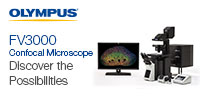Section Overview:
Charge-coupled devices (CCDs), like microprocessor and memory integrated circuits, are fabricated on silicon wafers in a series of elaborate steps using photolithography to define and build various functional elements within the microcircuitry. Each wafer contains tens to hundreds of identical devices, each fully capable of producing a single CCD chip for use in digital cameras. This section of the Olympus Microscopy Resource Center Photomicrography Primer contains links to illustrated discussions of important CCD concepts, which are critical in forming a complete understanding of digital imaging techniques.
Review Articles
Anatomy of a Charge-Coupled Device
Digital image sensor technology is centered around the semiconductor charge-coupled device, which is fabricated in a manner similar to that used in the production of integrated circuits.
Pixel Binning
Pixel binning is a clocking scheme used to combine the charge collected by several adjacent CCD pixels, and is designed to reduce noise and improve the signal-to-noise ratio and frame rate of digital cameras.
CCD Blooming
Under specific conditions where a CCD is exposed to very high intensity illumination, it is possible to exhaust the storage capacity of the CCD wells, a condition known as blooming.
Dynamic Range
In a CCD or CMOS image sensor, dynamic range is typically specified as the maximum achievable signal divided by the camera noise, where the signal strength is determined by the capacity, and noise is the sum of dark and read noises.
Quantum Efficiency
The quantum efficiency of a charge-coupled device (CCD) is a property of the photovoltaic response defined as the number of electron-hole pairs created and successfully readout by the device for each incoming photon.
CCD Noise Sources & Signal-to-Noise Ratio
For any electronic measuring system, the signal-to-noise ratio (SNR) characterizes the quality of a measurement and determines the ultimate performance of the system as discussed in this section.
Charge-Coupled Device (CCD) Linearity
An important characteristic of a scientific imaging system is the linearity in response to incident light, particularly when applied for quantitative photometric analysis as explained in this section.
Electronic Shutters
Electronic shutters are employed in charge-coupled devices (CCDs) to control integration time (exposure) of the photodiode array and reduce smear when capturing moving objects in the microscope.
Charge Transfer Clocking Schemes:
Two Phase CCD ClockingA two phase charge transfer CCD clocking scheme employs four gates for each pixel, with adjacent gates connected together as pairs.
Charge Transfer Clocking Schemes:
Three Phase CCD ClockingThree phase CCD clocking improves spatial resolution over that obtained in four phase devices, yet requires only three gates per pixel.
Charge Transfer Clocking Schemes:
Four Phase CCD ClockingA four phase CCD has four polysilicon gate electrodes in each pixel cell, each of which requires a separate input clock signal to transport accumulated charge.
CCD Scanning Formats
CCD digital imaging sensors are capable of acquiring images in one of three formats: point scanning, line scanning, and area scanning. Each of these formats has specific applications in digital photography.
Full-Frame CCD Architecture
Full-frame charge-coupled devices feature high-density pixel arrays capable of producing digital images with the highest resolution currently available and has been widely adopted due to the reliability and ease of fabrication.
Frame-Transfer CCD Architecture
Frame-Transfer charged coupled image sensors have architecture similar to full-frame CCDs. These devices have a parallel register that is divided into two separate identical areas, termed the Image and Storage arrays.
Interline Transfer CCD Architecture
Interline CCD architecture is designed to compensate for the shortcomings of frame-transfer CCDs. These devices are composed of a separate photodiode and an associated CCD storage region into each pixel element.
Microlens Arrays
Microlens arrays (also referred to as microlenticular arrays or lenslet arrays) are used to increase the optical fill factor in CCDs, such as interline devices, that suffer from reduced aperture due to metal shielding.
Metal Oxide Semiconductor (MOS) Capacitor
At the heart of all CCDs is a light-sensitive metal oxide semiconductor (MOS) capacitor, which has three components consisting of a metal electrode (or gate), an insulating film of silicon dioxide, and a silicon substrate.
Avalanche Photodiodes
Avalanche photodiodes provide gain by the generation of electron-hole pairs from an energetic electron that creates an "avalanche" of electrons in the substrate as explained in this article.
Photomultiplier Tubes
A photomultiplier tube is a photoemissive device in which the absorption of a photon results in the emission of an electron, and is useful for light detection of very weak signals.
Proximity-Focused Image Intensifiers
Learn more about image intensifiers in this section as they were developed to enhance our night vision and are often referred to as wafer tubes or proximity-focused intensifiers.
Electron-Bombarded CCDs
The EBCCD is a hybrid of the image intensifier and the CCD camera, which has just been recently introduced. In this device, photons are detected by a photocathode similar to that in an image intensifier.
Electron Multiplying CCDs
The topic discussed in this section is primarily about an innovative method of amplifying low-light-level signals above the CCD read noise is employed in electron multiplying CCD technology.
Sequential Color CCD Sytems
Three-pass sequential color CCD imaging systems employ a rotating color wheel to capture three successive exposures in order to obtain the desired RGB (red, green, and blue) color characteristics of a digital image.
Digital Imaging Java and Flash Tutorials
These tutorials are intended to allow visitors to adjust a variety of parameters and observe the effects of these changes, while providing technical information about the phenomena under study.
Selected Literature References
Digital Imaging Web Resources
As solid-state CCD technology rapidly overtakes traditional film and camera techniques, the number of digital camera manufacturers is constantly expanding to meet the needs of the industry. The links provided in this section point to the important manufacturers, trade magazines, and technical support information.



